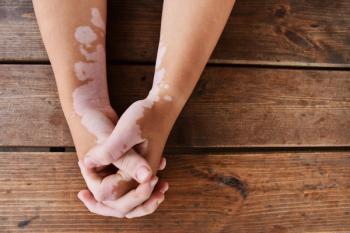
Cutaneous Leishmaniasis
The "Baghdad boil," as it is known in Iraq, usually begins as a papule at the site of a sandfly bite. This progresses to a nodule and then an ulcer, which eventually crusts over. The ulcer is typically painless, unless infected. The female sandfly is a common vector of transmission of cutaneous leishmaniasis. Most cases are caused by Leishmania major in dry desert areas and Leishmania tropica in urban areas. Tissue biopsy remains the gold standard diagnostic test for the disease.2,4,5
FigureThe "nonhealing" ulcer on this child's cheek is a manifestation of leishmaniasis. The disease is rare in the United States, but it is endemic in many other countries, including Iraq, where this patient was seen. Currently, 350 million persons are affected by this disease in its various forms-cutaneous, mucocutaneous, and visceral.
1,2
Cutaneous disease, the most common form, has affected numerous US soldiers deployed in Iraq and Afghanistan.
3
The "Baghdad boil," as it is known in Iraq, usually begins as a papule at the site of a sandfly bite. This progresses to a nodule and then an ulcer, which eventually crusts over. The ulcer is typically painless, unless infected. The female sandfly is a common vector of transmission of cutaneous leishmaniasis. Most cases are caused by Leishmania major in dry desert areas and Leishmania tropica in urban areas. Tissue biopsy remains the gold standard diagnostic test for the disease.2,4,5
Most patients heal without treatment and are immune to further infection. However, the lesions can leave disfiguring scars. Pentavalent antimony (dosage based on the patient's weight) for 20 days remains the treatment of choice for cutaneous leishmaniasis. Although not FDA-approved, this treatment is available through the CDC. Amphoterin B is reserved for patients in whom antimony is ineffective or who are resistant to the agent. Topical paromomycin is an effective therapy for cutaneous leishmaniasis caused by L major; it can be combined with antimonial compounds. Oral antifungal therapy and azithromycin have shown varied results.2,3,5
Prevention is a key part of treatment. Wearing protective clothing (permethrin-treated clothing can be used for added protection) and the use of bed nets, insect repellent with deet, and pesticides can reduce the number of sandfly bites.2,4,5
This child was treated with paromomycin ointment. He was scheduled to return in 4 to 6 weeks but was lost to follow-up.
References:
- World Health Organization. Leishmaniasis. Disease information. Available at: http://www.who.int/tdr/disease/leish/diseaseinfo.htm. Accessed February 21, 2008.
- Markle WH, Makhoul K. Cutaneous leishmaniasis: recognition and treatment. Am Fam Physician. 2004;69:1455-1460.
- Centers for Disease Control and Prevention. Cutaneous leishmaniasis in US military personnel-Southwest/Central Asia, 2002-2003. MMWR. 2003;52: 1009-1012.
- Khan SJ, Muneeb S. Cutaneous leishmaniasis in Pakistan. Dermatol Online J. 2005;11:4.
- Lee MB, Gilbert HM. Current approaches to leishmaniasis. Infect Med. 1999; 16:34, 37-45.
The opinions and assertions contained herein are the private views of the author and should not be construed as official or as reflecting the views of the Department of the Army or the Department of Defense.
Newsletter
Access practical, evidence-based guidance to support better care for our youngest patients. Join our email list for the latest clinical updates.









